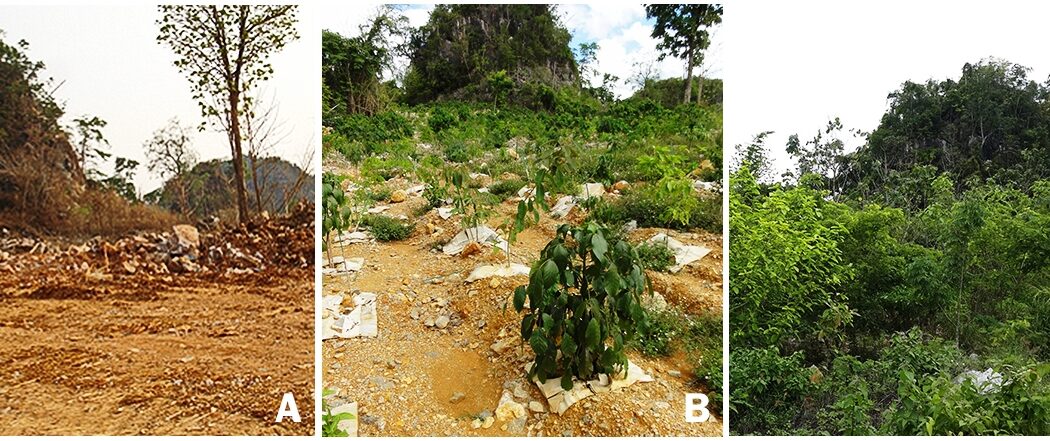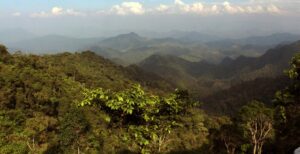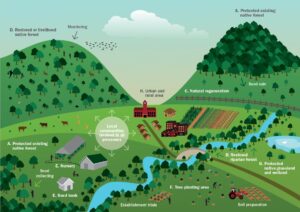On January 25, 2021, scientists from the Royal Botanic Gardens, Kew (RBG Kew) and Botanic Gardens Conservation International (BGCI) have set out ten “golden rules” for reforestation, published an open-access article in the leading journal Global Change Biology.
These rules have been set by the experts in response to the damage some large-scale tree planting schemes are seen to be inflicting on the environment and to provide nature-based solutions to protect and restore global forests. The list highlights how forests can be restored with the simultaneous triple benefit of maximising carbon capture to mitigate global warming, recovering ecosystems, and helping people’s livelihoods.
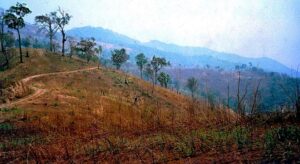
Destroyed forest in Thailand (before restoration). Credit Stephen Elliott, Forest Restoration Research Unit, Chiang Mai University, Thailand.
Dr. Kate Hardwick, Conservation Partnership Coordinator at RBG Kew and a lead author of the paper says, “Tree planting now dominates political and popular agendas and is often presented as an easy answer to the climate crisis, as well as a way for corporate companies to mitigate their carbon emissions, but sadly, it isn’t as simple as that. When people plant the wrong trees in the wrong place, it can cause considerably more damage than benefits, failing to help people or nature. Our paper sets out to look at these issues and create a framework for people, businesses and policymakers to use for future reforestation projects that can aid both people and the environment.”
This paper comes out ahead of a virtual conference—held by RBG Kew and BGCI, Reforestation for Biodiversity, Carbon Capture and Livelihoods—which will run over three days from February 24-26, 2021. The event, with Sky Zero as headline sponsor, will bring together a series of interesting global perspectives to debate and challenge the myth that ‘all tree planting is good’ and to discuss best practice for protecting and restoring the world’s forests.
The conference will be opened by HRH The Prince of Wales and it is hoped the discussions will raise the standard of reforestation globally and support discussions in the run up to – and initiatives arising from – the critical agenda-setting UN conferences (COP15 and COP26) later this year on new global biodiversity and climate change agreements.
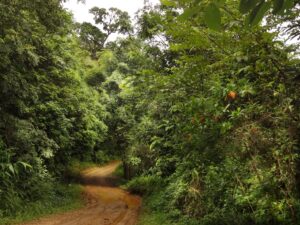
That same forest in Thailand after restoration. Credit Stephen Elliott, Forest Restoration Research Unit, Chiang Mai University, Thailand
Professor Alexandre Antonelli, Director of Science at RBG Kew and senior author of the paper explains, “Forests are crucial to all life on Earth. They provide a home to 75% of the planet’s plants and animals, they provide us with food, fuels and medicine and are incredibly important for our mental health and wellbeing. But they are disappearing at an alarming pace; we lose an area of tropical rainforest twice the size of Wales every year. It is therefore fantastic that thousands of people and businesses are planting trees. Our paper doesn’t set out to say that tree planting is wrong, it is a brilliant solution to tackle global warming and protect biodiversity, when done correctly and effectively. Instead, we want our paper and upcoming conference to challenge the way we currently plant trees so that we can maximise impact and herald a new era for the world’s forests that benefits everyone. And whenever there’s a choice, we stress that halting deforestation and protecting remaining forests must be a priority.”
There are many ambitious tree-planting initiatives underway across the globe, all of which aim to capture enormous quantities of carbon to compensate for the huge CO₂ emissions that are a major cause of rising global temperatures. The authors looked at such initiatives and found that in some cases planned tree planting does not actually increase carbon capture and can have long-term negative impacts on biodiversity, landscapes and livelihoods.
One such example is in South Africa, when the non-native Australian acacias were introduced for dune stabilisation and timber during the 19th and 20th centuries. The acacias became invasive, spreading widely across vast areas of land, taking over the natural heathlands and grasslands and lowering the water table. It now costs the country the equivalent of millions of pounds to clear them every year.
The scientists’ ten golden rules set out below aim to ensure that new and restored areas of forest become effective, long-term carbon sinks, stop the loss of forest biodiversity and support the livelihoods of local people. The rules cover all stages of the reforestation process, from selecting the right site and the right species, through to using the forest to generate a sustainable income for local people. They emphasize the importance of protecting existing forest and working collaboratively.
10 Golden Rules for Restoring Forests in summary:
- Protect existing forests first;
- Put local people at the heart of tree-planting projects;
- Maximise biodiversity recovery to meet multiple goals;
- Select the right area for reforestation;
- Use natural forest regrowth wherever possible;
- Select the right tree species that can maximise biodiversity;
- Make sure the trees are resilient to adapt to a changing climate;
- Plan ahead;
- Learn by doing; and
- Make it pay.
Dr. Paul Smith, Secretary General at BGCI and co-author of the paper says, “These ten rules highlight that planting trees is highly complex. There is no universal, easy solution to a successful reforestation initiative given the extraordinary diversity of trees, forest types and the unique cultural and economic environments each forest is in. However, there are successful examples that we can learn from and develop further to build on current public and private interest in the topic. The past 30 years of research and practice has given us the tools to feasibly restore millions of hectares of forest around the world if these 10 golden rules are taken into consideration. Planting the right trees in the right place must be a top priority for all nations as we face a crucial decade for ensuring the future of our planet.”
The 10 Golden Rules in more detail
Protect existing forests first
Before planting new acres of forest, the authors argue we must first prioritise the protection of remaining forests to safeguard those carbon stocks, their ecological functions and their biodiversity. Deforestation continues relentlessly, despite global efforts to stop it but reforestation or planting a new site in return for one destroyed is not the best solution to the problem – keeping forests in their original state is always preferable.
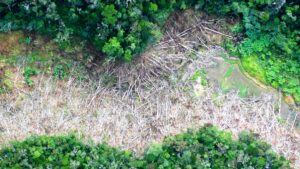 Undamaged, old growth forests are major long-term carbon sinks due to their complex structure and diverse mix of species, which increase their resilience to climate change threats such as fire, storms and drought.
Undamaged, old growth forests are major long-term carbon sinks due to their complex structure and diverse mix of species, which increase their resilience to climate change threats such as fire, storms and drought.
As the International Panel on Climate Change (IPCC) says, “most destroyed forest ecosystems will take longer than 100 years to return to their previous undisturbed state”. Full recovery of ecosystems can take centuries, especially the return of rare or endemic species and their complex biological interactions, which are even more vulnerable to disturbance. Decline in original forests also threatens indigenous cultures, traditions and livelihoods.
Action at both national and local levels is needed to protect forests – persuading governments and corporations to create and enforce protected areas and legislate against forest conversion can be effective. As shown in the recent example of Ebo Forest, where scientists at the Royal Botanic Gardens, Kew alongside other partner organisations, used plant extinction assessments to convince the Cameroon government to withdraw their logging concessions, which would have devastated a globally important area for biodiversity.
Put local people at the heart of tree-planting projects
Involving local communities as part of the stakeholder engagement is imperative, say authors of the paper. Best practice for community involvement in a reforestation project means involving local people right at the beginning, from the planning stage through to delivery and management of the forest. Previous studies of global forestation projects cite lack of community involvement as one of the most common causes of project failure.
Increased engagement with local people increases the positive outcomes of a project, creating fair and equal benefits to the community. For example, it is local communities that will often look after the forest, prepare the land, plant the trees, and maintain the site, all of which diversifies local employment and improves livelihoods. There are also further benefits to the community around wellbeing, natural capital and increased knowledge.
The authors found several examples of successful tree-planting schemes with local people at the heart of them, including a community-based forest management project in Nepal, a system called ‘ngitili’ in Tanzania that uses traditional local knowledge to underpin collective land management, and a community-led reforestation project using local indigenous species in eastern Madagascar where members of the community worked together to restore areas degraded by fire and over-exploitation.
Maximise biodiversity recovery to meet multiple goals
Restoring biodiversity that will maximise carbon sequestration and help deliver socio-economic benefits is key when reforesting an area. Rather than being an end goal, the authors say reforestation should be a way of achieving various goals; not only climate change mitigation, but also species conservation, improved economic conditions for communities, food security, and stability of soil and water systems. Meeting as many of these goals as possible whilst doing no harm to local communities, native ecosystems and vulnerable species marks a highly successful tree-planting project.
Where the main goal is timber production to improve economic prospects for local people, plantations of fast-growing monocultures are widely used. However, the authors argue that in the long-term, restoring native forests rather than planting cultivated trees captures far more carbon, conserves biodiversity and can also deliver economic returns for communities. Restored native forests can deliver food, fibre and medicine for livelihoods and recreational, educational and cultural benefits for people.
Select the right area for reforestation
Even though reforestation is always implemented at the local scale, decisions can often be made at a global scale, especially with the emerging engagement of international organisations in tree-planting initiatives.
In the paper, the scientists advise that global decisions on which area to reforest should address key criteria such as avoiding previously non-forested lands, connecting reforested sites to existing forest to expand the forested area where possible and being aware of displacing activities that could cause deforestation elsewhere.
Ultimately, the best area for planting trees would be a previously forested land that has become degraded, avoiding non-forested landscapes such as natural grasslands, savannas or wetlands whose own individual ecosystems already contribute greatly to capturing carbon, mostly in the soil. It would also be in an area where trees could deliver other ecosystem services, such as recreational spaces, wildlife habitats, clean air and shade, whilst avoiding areas which could displace agriculture forcing further deforestation or social conflicts elsewhere.
The authors recognise that more tools are needed to help guide reforestation and make better decisions. Maps identifying high-priority areas for intervention, developed as a result of pledges to the Bonn Challenge, are a great start.
Advances in remote sensing and drone technology are also helping to prioritize and monitor areas of degraded forest for restoration. Scientists at Kew are currently using these technologies in Brazil and Peru, to identify and quantify how natural habitats are being devastated by human activities and climate change.
Use natural forest regrowth wherever possible
Natural regeneration, the process of natural forest regrowth which occurs spontaneously after land is abandoned, can be cheaper and more efficient than tree planting if landscape conditions are suitable, say the authors. This can be achieved by simply protecting the area from further damage, or with appropriate human intervention and works best on lightly degraded sites and those close to existing forests that function as seed sources.
Carbon capture in naturally regenerated areas is potentially 40 times greater than in plantations and species richness is generally higher. Studies in Brazil also show that selecting areas for reforestation based on their natural regeneration potential can cut reforestation costs by up to two thirds, potentially saving billions of dollars when applied at a national scale.
Select the right trees that can maximise biodiversity
When natural regeneration is not possible and tree planting is needed to restore forest, picking the right trees is crucial say the scientists. They advise that a mix of species should always be planted, typical of the local natural forest ecosystem and including rare and endangered species, in order to create a rich ecosystem.
Maximising biodiversity depends not only on the number of species reintroduced but also on the functions they perform. The authors suggest prioritising trees that provide mutualistic interactions, such as those between native tree species and fungi, seed-dispersing animals and pollinators, is vital to achieving a resilient, biodiverse and restored environment. Avoiding exotic species that could become invasive is also imperative – invasive species are an important driver of the current global biodiversity crisis. They have long-term effects on the environment, competing with native species, reducing biodiversity and often reducing the water availability.
A good example where the right trees were picked to achieve a restored forest with mutualistic interactions is in Lampang Province in northern Thailand. A previously forested site which had been degraded through limestone mining was restored by Siam Cement Group and Chiang Mai University. After spreading 60 cm of topsoil, they planted 14 different native tree species including several species of figs, and legumes to improve the soil conditions.
By the end of the third rainy season, canopy closure had been achieved and macaque monkeys started visiting the plot to eat the fig fruits, naturally dispersing the seeds of other species through defecation. Overall, the trees had an average annual growth rate of 91%.
Make sure the trees are resilient to future change
To ensure the survival and resilience of a planted forest, the authors state it is vital to use tree seeds with appropriate levels of genetic diversity that are suitable for the local climate or projected climate, consistent with regional genetic variation. Using seeds with low genetic diversity generally lowers the resilience of restored forests, which can make them disease-prone and unable to adapt to climate change.
Plan ahead
Whether restoring a forest with tree saplings or tree seeds, appropriate infrastructure and seed supply systems are essential. Deciding in advance where to source seeds or purchase trees needs to be planned for. Projects must be prepared to develop their own seed collections or storage and propagation capacity, if not available regionally. Likewise, with saplings, in-house nurseries need to be built or an accredited nursery found that can help. The authors suggest it is always best to work with local people as they are important sources of labour and expertise.
Learn by doing
The best planning decisions for tree-planting schemes are made when scientific knowledge is combined with indigenous knowledge, the authors advise. Traditional knowledge acquired over many generations by people who have lived close to the forest is incredibly useful, whereas field experiments by scientists, although also important, may take a long time to yield results. Science can be used to provide more specific information to help aid species selection, for instance considering the ability of particular species to withstand future climate changes, and to propagate species that may never have been cultivated before, where producing viable seedlings can be a practical challenge.
Ideally, small-scale trials should take place before large-scale tree planting commences – this helps to ensure the right trees are used, to test their effectiveness in overcoming obstacles such as degraded soils or competitive species. Again, this can take years, so local knowledge is crucial. Plants and birds can be used as biodiversity indicators to assess how well the ecosystem is recovering.
Make it pay
Income generation by selling forest products from livelihood forests is easily achieved, whereas marketing environmental services from existing and restored native forest is more difficult, say the authors, especially in protected areas. The sustainability of forest restoration depends on the income streams generated from it exceeding those from alternative land–uses, and on that income being shared fairly among all stakeholders, including the poorest.
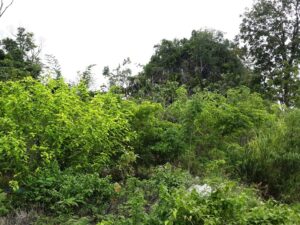
Example of successful tree planting in Lampang Province in Thailand. Credit Siam Cement Group and SE.
The authors cite the UN’s REDD+ strategy (a voluntary climate change mitigation approach to reduce emissions from deforestation and forest degradation and to enhance forests as carbon sinks in developing countries) as making some progress in monetizing forests as carbon sinks.
Forest carbon value alone often exceeds revenue from the main drivers of deforestation such as palm oil, but application of REDD+ to incentivize reforestation has been challenging at times due to governance issues and socio-economic conditions, often not benefitting all stakeholders. Revenue could also be generated from other ecosystem services provided by forests, such as the protection of river catchments in upland areas. However, this would require increased awareness and marketing to drive financial investment into the natural capital services provided by restored forests.
To ensure revenue flows mostly into local economies, local people should have direct access to carbon markets and start-up loans to fund restoration work, minimizing the role of third-party agents. Ecotourism can also be lucrative for local income, directly monetizing biodiversity, but again substantial start-up funding is needed, and skilled labour is required to meet the demands of ecotourists.
All photos are courtesy of RGB Kew unless otherwise credited.
Register (free) for “Reforestation for biodiversity, carbon capture and livelihoods” conference.

